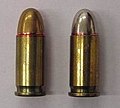Full metal jacket bullet
| Advanced search |
- About 3 results found and you can help!
A full metal jacket (or FMJ) is a bullet consisting of a soft core (usually made of lead) encased in a shell of harder metal, such as gilding metal, cupronickel or less commonly a steel alloy. This shell can extend around all of the bullet (alternatively termed a total metal jacket round) or, more often, just around the front and sides with the rear lead part left exposed. The jacket allows for higher muzzle velocities than bare lead without depositing significant amounts of metal in the bore. It also prevents damage to bores from steel or armor-piercing core materials. The appearance of FMJ ammunition is highly distinctive when compared to hollow-point or soft point bullets. Historically, the first successful full metal jacket rifle bullets were invented by Lt. Col. Eduard Rubin of the Swiss Army in 1882. Full metal jacket bullets were first used as standard ammunition in 1886, for the French Mle 1886 Lebel rifle.
- See also: Wikipedia
- Related: Soft point bullet, Hollow-point bullet
| Declaration (IV, 3) concerning Expanding Bullets Declaration (IV, 3) concerning Expanding Bullets www1.umn.edu/humanrts/instree/1899f.htm - Web |
| European Ammunition Box Translations European Ammunition Box Translations www.rawles.to/Euro_Box_FAQ.html - Web |
| Photos showing terminal effects of British Mark 7 ... Photos showing terminal effects of British Mark 7 .303 bullets www.theboxotruth.com/docs/bot37.htm - Web |
Gallery for «Full metal jacket bullet»
Average relevance





